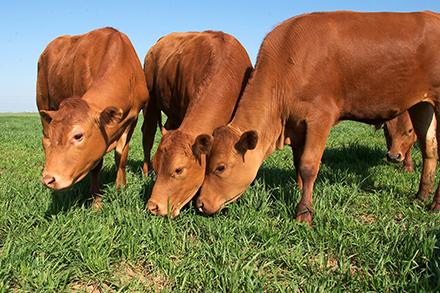Commemorating the Groundbreaking Research of George W. Pugh Jr

Cattle grazing. Photo by Stephen Ausmus.
February commemorates Black History Month, which honors the accomplishments of black Americans in all areas of endeavor throughout our history. In observance of Black History Month 2023, we recognize the groundbreaking research of ARS scientist George Washington. Pugh Jr. (1934- 2012).
Pugh was born in 1934 in Hurtsboro, AL. After serving with the U.S. Army in Korea, Pugh received a Doctor of Veterinary Medicine degree in 1961 from the Tuskegee Institute in Tuskegee, AL. He then moved to Ames, IA, where he was employed at the USDA, Agricultural Research Service (ARS), National Animal Disease Center. Pugh was one of the first black scientists hired by the ARS division of the USDA.
The National Animal Disease Center conducts research on diseases of economic importance to the U.S. livestock and poultry industries, including a cattle eye disease known as infectious bovine keratoconjunctivitis (IBK), commonly known as pinkeye. Like pinkeye in humans, IBK is highly contagious in cattle. IBK infections cause redness, ulcers, and pain in the eyes and in severe cases can result in blindness. Infection can also lead to decreased milk production and reduced weight gain in calves.
Any of these consequences can have detrimental impacts on the infected animals and, economically, on the entire beef producing industry.
During his time at ARS, Pugh conducted crucial early research on pinkeye, publishing more than 50 papers on the topic and making major advances in understanding the role of the bacterium Moraxella bovis as a pathogen that can cause pinkeye in cattle.
Between 1971 and 1986, he and his co-author David Hughes published 19 articles on M. bovis vaccines. One particular study looked at the efficacy of vaccinating calves with a bacterin from nonhemolytic strains of Moraxella bovis. Other studies looked at the effectiveness of a pilus vaccine against exposure to homologous strains of Moraxella bovis. [https://pubmed.ncbi.nlm.nih.gov/931134/] [https://pubmed.ncbi.nlm.nih.gov/1247198/]
Another important area of Pugh’s research focused on isolation and identification of Moraxella bovis field strains. In fact, the strains of M. bovis that he isolated as part of his 1969 PhD dissertation are still vital to the research being done in the field today, and are used in everything from genomics to vaccines and experimental studies.
Building upon that work, approximately 58 years later, scientists from ARS and University of Nebraska-Lincoln (UNL) sequenced and compared the genomes of a collection of M. bovis variants and found that they consisted of two major genotypes. The researchers identified DNA differences between the genotypes and found substances that can potentially be used as targets to control the disease.
Dustin Loy, UNL veterinary diagnostic microbiologist who was part of the collaborative research team, reflected on Pugh’s work.
"In my opinion Dr. Pugh was the most impactful scientist to ever study this disease (Bovine Pinkeye/IBK). His work is elegant and foundational to nearly all we know about this disease. I am frequently asked by veterinarians specific and sometimes obscure questions about this topic and nearly always Dr. Pugh had published a study to examine the question they were looking to answer."— Nancy Vanatta, ARS Office of Communications.

